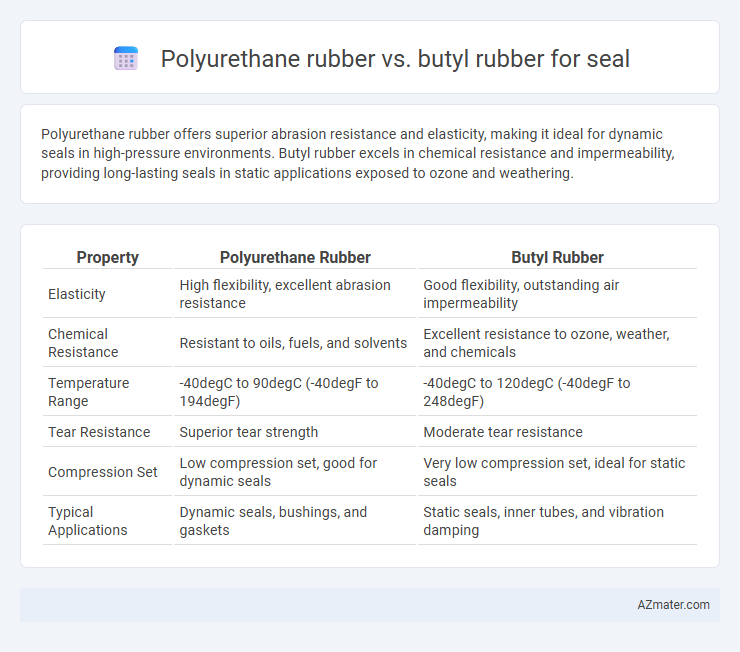Polyurethane rubber offers superior abrasion resistance and elasticity, making it ideal for dynamic seals in high-pressure environments. Butyl rubber excels in chemical resistance and impermeability, providing long-lasting seals in static applications exposed to ozone and weathering.
Table of Comparison
| Property | Polyurethane Rubber | Butyl Rubber |
|---|---|---|
| Elasticity | High flexibility, excellent abrasion resistance | Good flexibility, outstanding air impermeability |
| Chemical Resistance | Resistant to oils, fuels, and solvents | Excellent resistance to ozone, weather, and chemicals |
| Temperature Range | -40degC to 90degC (-40degF to 194degF) | -40degC to 120degC (-40degF to 248degF) |
| Tear Resistance | Superior tear strength | Moderate tear resistance |
| Compression Set | Low compression set, good for dynamic seals | Very low compression set, ideal for static seals |
| Typical Applications | Dynamic seals, bushings, and gaskets | Static seals, inner tubes, and vibration damping |
Introduction to Polyurethane and Butyl Rubber
Polyurethane rubber offers exceptional abrasion resistance, flexibility, and durability, making it ideal for seals subjected to high wear and mechanical stress. Butyl rubber excels in impermeability to gases, chemical resistance, and excellent sealing properties under extreme weather and temperature variations. Choosing between polyurethane and butyl rubber seals depends on specific application needs such as exposure to chemicals, temperature range, and mechanical wear.
Chemical Composition and Structure
Polyurethane rubber consists of urethane linkages formed by the reaction of polyols and isocyanates, resulting in a segmented copolymer with hard and soft segments that provide high abrasion resistance and flexibility. Butyl rubber is a copolymer of isobutylene with a small percentage of isoprene, characterized by a saturated hydrocarbon backbone that offers excellent impermeability to gases and superior resistance to chemicals and weathering. The differing chemical compositions and molecular structures account for polyurethane's toughness and elasticity, while butyl rubber excels in sealing applications requiring airtightness and chemical stability.
Key Physical Properties Comparison
Polyurethane rubber exhibits higher tensile strength, abrasion resistance, and elasticity compared to butyl rubber, making it ideal for dynamic sealing applications requiring durability. Butyl rubber offers superior impermeability to gases and excellent resistance to heat, chemicals, and weathering, ensuring reliable sealing in static or harsh environmental conditions. Both materials provide unique advantages, with polyurethane favored for mechanical robustness and butyl prioritized for chemical and environmental stability.
Durability and Longevity for Sealing
Polyurethane rubber exhibits superior abrasion resistance and high tensile strength, making it highly durable for sealing applications exposed to mechanical wear and harsh environments. Butyl rubber offers excellent impermeability to gases and outstanding resistance to weathering, ozone, and chemical degradation, ensuring long-term sealing performance under static conditions. For applications requiring robust durability against physical stress, polyurethane is ideal, while butyl rubber excels in longevity where chemical resistance and airtight seals are critical.
Resistance to Chemicals and Oils
Polyurethane rubber exhibits excellent resistance to petroleum-based oils, fuels, and hydraulic fluids, making it ideal for seals exposed to aggressive chemical environments. Butyl rubber offers superior resistance to polar chemicals, acids, and alkalis but has limited compatibility with oils and hydrocarbons. Selecting between polyurethane and butyl rubber depends on the seal's exposure to specific chemicals, with polyurethane preferred for applications involving oils and Butyl for acidic or alkaline conditions.
Performance in Extreme Temperatures
Polyurethane rubber offers superior abrasion resistance and maintains flexibility in temperatures ranging from -40degC to 90degC, making it suitable for seals exposed to moderate temperature variations. Butyl rubber excels in sealing applications within extreme cold environments, with performance stable down to -55degC, and retains excellent air impermeability up to 120degC. For high-temperature resistance and durability in cold conditions, selecting butyl rubber seals provides enhanced reliability over polyurethane options.
Flexibility and Elasticity Differences
Polyurethane rubber exhibits superior elasticity, allowing it to return to its original shape quickly after deformation, making it highly suitable for dynamic sealing applications requiring frequent movement. Butyl rubber, while less elastic, offers excellent flexibility especially at low temperatures, providing durable seals that maintain flexibility without cracking. The key difference lies in polyurethane's higher tensile strength and elasticity, contrasted with butyl's enhanced impermeability and long-lasting flexibility under varying environmental conditions.
Water and Air Tightness Capabilities
Polyurethane rubber offers excellent water tightness due to its high resistance to hydrolysis and abrasion, making it ideal for dynamic seals exposed to moisture. Butyl rubber excels in air tightness because of its low gas permeability and exceptional resistance to ozone and weathering, ensuring long-term sealing efficiency in static applications. Seal performance depends on specific environmental conditions, with polyurethane better for harsh wet environments and butyl suited for airtight containment.
Cost-Effectiveness and Availability
Polyurethane rubber offers superior abrasion resistance and tensile strength, making it cost-effective for high-performance sealing applications despite a higher initial price. Butyl rubber provides excellent impermeability and chemical resistance at a lower cost, ensuring affordability for general sealing needs with widespread availability. Availability of butyl rubber is greater in bulk quantities due to established production, while polyurethane may require specialized sourcing depending on the grade.
Best Applications: When to Choose Polyurethane or Butyl Rubber
Polyurethane rubber excels in seals requiring high abrasion resistance, tensile strength, and elasticity, making it ideal for dynamic environments like automotive and industrial machinery. Butyl rubber offers superior impermeability and chemical resistance, suited for static sealing applications such as gas masks, tire inner liners, and pharmaceutical closures. Selecting polyurethane is best for wear-intensive, flexible seals, while butyl is preferred for airtight, chemical-resistant seals demanding long-term durability.

Infographic: Polyurethane rubber vs Butyl rubber for Seal
 azmater.com
azmater.com